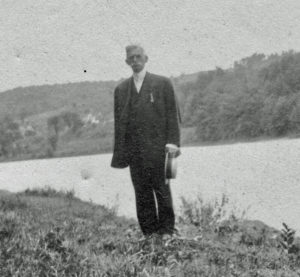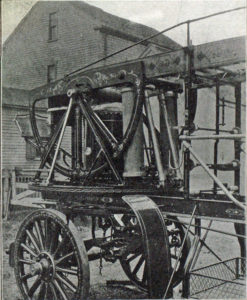True Tales from Canton’s Past: Cornelius Callahan
By George T. ComeauInvention is both art and science. The mind of an inventor is complex and patient. These are the people who ask “what if?” and are the people who study process to improve or even save lives. There is no better case for the inventor than that of Cornelius Callahan. It was Callahan who invented and perfected fire safety equipment that saved hundreds of thousands of lives at the turn of the last century.
Firefighting started out in many places as a fraternal organization where men would volunteer their time to help protect a small section of a community. In the Canton of the mid 19th century there were a few volunteer fire companies that enjoyed gentle rivalries and a communal sense of fraternity. As the late 1800s saw enormous fires consume cities with devastating results, the professional fire department came into being. And with the rise of a profession also came the advent of new tools to help combat fires. A man from Canton would invent the most significant tools ever used to fight fires.
Cornelius Callahan was born in 1840 in the small village of Clandrohad, County Cork, Ireland. The family name was spelled Callaghan, but at some point, and this was fairly common, the surname was changed to Callahan. At a very early age, Callahan immigrated to the United States with his father, Daniel, and mother, Mary, along with brother Jeremiah and an older sister, Mary. Settling in Canton sometime before 1850, the Irish immigrant family found a place where many of their people had been flourishing for more than 20 years. The mills of Canton had plenty of work and the Callahan neighbors were carpenters, laborers, shoemakers and blacksmiths. Canton was no longer rural and not yet fully industrial, and it seems the young boy had his eye on industry at a very close level.
Big brother Jeremiah was eight years older than Cornelius and became a shoemaker. Just prior to his 21st birthday, Jeremiah died of tuberculosis and was among one of the earliest burials at St. Mary’s Cemetery. Meanwhile, Mary Callahan married a man by the name of John Murphy, who was the schoolmaster at the Gridley School. It may be likely that Cornelius attended the Gridley School, but his education was limited.
By age 22, Callahan was a machinist living in a boarding house in Boston. Surprisingly, given his stature, there is little known of his early life. The noted Canton historian Ed Lynch did extensive research on Callahan and had discovered that he was a gunsmith during the Civil War. Lynch wrote, “For a man only in his early 20s, this was no mean accomplishment.”
After the war, Callahan went to work for a fire hose company. Aside from being a fantastic inventor, he also had a great public relations machine at his disposal. Later news articles credit him with starting the American Fire Hose Company of Boston. It is unlikely that he started the company, but he did create enormous value by assigning certain patents to American Fire Hose. While at the company, Callahan perfected a machine for the weaving seamless hose, and in doing so revolutionized the entire firefighting industry.
The fact that Callahan is credited with the invention of the modern (for the time) fire hose is incredible. At the height of his invention the fire hose that he developed was in every major city in America. Fire departments depended upon this hose to run thousands of feet in all sorts of directions and not kink during a fire. Callahan spent most of his life inventing and tinkering with fire apparatus. Callahan received patents for couplings used to connect hoses together and also the tools used to tighten and loosen the couplings. In 1872 he reorganized the American Fire Hose Company, of Chelsea, Mass., and continued with that concern until 1885.
The patent for his fire hose made him a very comfortable man. The patent issued was called a “bottom patent” and is one in which the invention is the foundation for all improvements to come. At the time, Callahan’s patent was the fourth such bottom patent — the others being the telegraph, a harvesting reaper, and the sewing machine. As you can imagine, this was a big deal.
And since Callahan had a sharp business mind, he assigned the patent as needed and defended it vigorously against infringement. The fire hose was superb, and according to Ed Lynch, “His finished hose was tested by the engineers of the U.S. Navy at the Charlestown Navy Yard and withstood pressures up to 1,180 pounds before bursting.” This was a major lifesaving invention and Callahan reaped enormous benefits.
And yet with all that he accomplished in both the creation of the hose and the wealth he amassed, Callahan was not done. Sometime after 1885 he created his most famous invention, the Callahan Fire Nozzle. Selling the first nozzle to the chief engineer of the Pittsfield Fire Department was the breakthrough. Within a few months Callahan had partners, including the chief engineer that had purchased the first nozzle, and his fire supply business grew fast and grew big.
The success that attended the sale of the Callahan Fire Nozzle was astounding. A report of the day stated that, “There is scarcely a fire department of any importance in the land that is not equipped with Callahan shut-off nozzles. The sale of these appliances has reached the 6,000 mark, and it is a noticeable fact that, where others fail, the ‘Callahan’ has to be called into requisition. This is due to simplicity of construction and easy method of working. There are no screws, turning, or calculations to be made when using the Callahan shut-off nozzle. All that a fireman has to do is to pull down a small lever, and the water flows with little or no friction. This simple operation is of the greatest importance where time is everything at a fire. It is only natural that such a valuable and handy tool should be in favor. This nozzle has no ground joints, and it combines the great essentials of lightness, tightness and automatic packing. It has been tested for hours while working in weather below zero, without showing any sign of freezing. A fact that speaks for itself is that there are more Callahan shut-off nozzles in service than of all other makes combined.”
In 1879, as a result of sales pressure brought to bear by fire departments desirous of using his hose, he incorporated the Cornelius Callahan Company, and remained as its treasurer and general manager until 1892, when he opened a factory near his home at 57 Beaumont Street. In 1908, Callahan retired wealthy beyond imagination and was a generous benefactor to St. John’s Parish. The only outward sign of wealth was a love of race horses. Callahan owned a private racetrack off of Dedham Street where Hudson and Shawmut roads are today. Callahan died in 1922 and his wife, Margaret, died 10 years later; there were no children to inherit the fortune. The undisclosed amount of the entire Callahan wealth was left to the Catholic Archdiocese of Boston.
Short URL: https://www.thecantoncitizen.com/?p=56415












